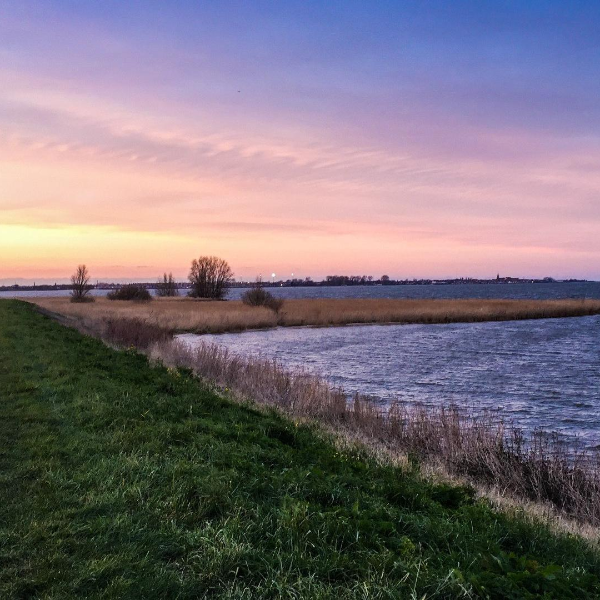Luc Kohsiek’s moonshot idea: a step towards achieving Paris targets within ten years

Luc Kohsiek’s moonshot idea: a step towards achieving Paris targets within ten years
In 1962, President John F. Kennedy made an inspiring, bold speech – also known as the Moonshot Speech – that rallied the United States behind a costly but highly successful space programme in which thousands of Americans pooled their knowledge, insights and energy to put the first man on the moon. We could use some of that ‘moonshot thinking’ in water management today. To wrap up and build on the Climate-Robust Water Systems webinar series, we are asking a variety of people from the world of science and water management to share their own moonshot ideas as well as what they are doing to achieve them. This time, we spoke to Luc Kohsiek.
On 1 January this year, at the age of 67, Luc Kohsiek (1953) began his third six-year term as chair of the Hollands Noorderkwartier water authority. Kohsiek is also chair of the knowledge centre for water authorities, STOWA (Foundation for Applied Water Research), which is celebrating its 50th anniversary this year. He’s an old hand in the water business and isn’t known for making grand declarations. But that’s not to say he’s not ambitious – quite the opposite, in fact.

Tell us a bit about yourself and what drives you as chair of a water authority
I’ve been chair of the Hollands Noorderkwartier water authority since 2009 and chair of STOWA since 2013. I originally trained as a physical geographer. Ever since I was a child, I’ve been fascinated by the physical world around me. I got that from my granddad. As a child, I used to visit him often. He was a small farmer near the river Linge. He had a few cows, an orchard and some arable land. My granddad lived with the seasons, with the weather, with the soil. He taught me that you can use nature for your own benefit, but you have to do it with respect – in a sustainable way. You have to be in step with nature.
What is your moonshot idea?
The way I see it, the biggest climate challenge we face is curbing carbon emissions. The Dutch government is aiming for a 49% reduction in carbon emissions relative to 1990 by 2030 and a 95% reduction by 2050. My moonshot idea would involve seeing that, in ten years' time, we are visibly on track to achieving this goal – and therefore to meeting the targets set out in the Paris climate agreement of limiting global warming to 1.5 degrees Celsius. If we fail, we’ll be entering uncharted and dangerous territory, also in terms of water management.
What will we need to do to get there?
The water authority is the fourth largest consumer of energy in North Holland. That comes with responsibilities. I’m proud that our board has set itself the goal of becoming a climate- and energy-neutral water authority by 2025. To help achieve this, we recently installed around 100,000 solar panels. We’re also preparing to install a series of wind turbines but, as we all know, that’s easier said than done.
How can you contribute to this as chair of a water authority?
I made a passionate appeal to our board to achieve energy and climate neutrality by 2025. That might seem like a drop in the ocean, but we need every drop – including ours. Our water authority is also involved in all kinds of adaptation measures and, rather than hard structures, we’re looking for nature-based solutions. I got that from my granddad.
In Hoorn, for example, we decided to build a new dyke which also serves as an urban beach in front of the existing Markermeer dyke. On Texel, we reinforced a section of the Wadden Sea dyke with a three-kilometre-long sand dyke in the Wadden Sea. Both of these projects combine safety with more nature while also saving valuable agricultural land inside the dyke. The idea is to work with nature, not against it. We saw just how well that works this summer in Limburg, where the Room for the River projects saved the province from much greater disaster.
And as an individual?
We have solar panels on the roof and I drive a hybrid car. At home, using as little energy as possible has become a kind of sport. We don’t eat meat, and we think twice before flying. We only fly now for the occasional intercontinental trip.
And finally, a question from our previous Moonshot guest, Karin Snel
Researcher Karin Snel, our previous moonshot guest, pointed out that water authorities still tend to provide reassurance whenever there’s a flood. But this doesn’t instil in most people a sense of urgency, the idea that they can and should do something themselves to limit water issues. Even though, as she says, there is a lot they can do themselves. She is interested to hear your take on that.
I completely agree with her. Our communication lags behind the reality of the situation. In our defence, in the 1980s 40mm of rain in one hour was the worst we could expect; now it’s 80mm. It’s become simply impossible for us as a water authority to keep everything dry all of the time. We need to communicate that better. We also need to show that there is a lot that farmers, citizens and people living in the countryside can do themselves to tackle the causes of climate change – but also to limit the consequences. For example, by implementing measures at home. We need to adopt a different communication strategy to mobilise others to take action. That’s something we will be doing in the near future.